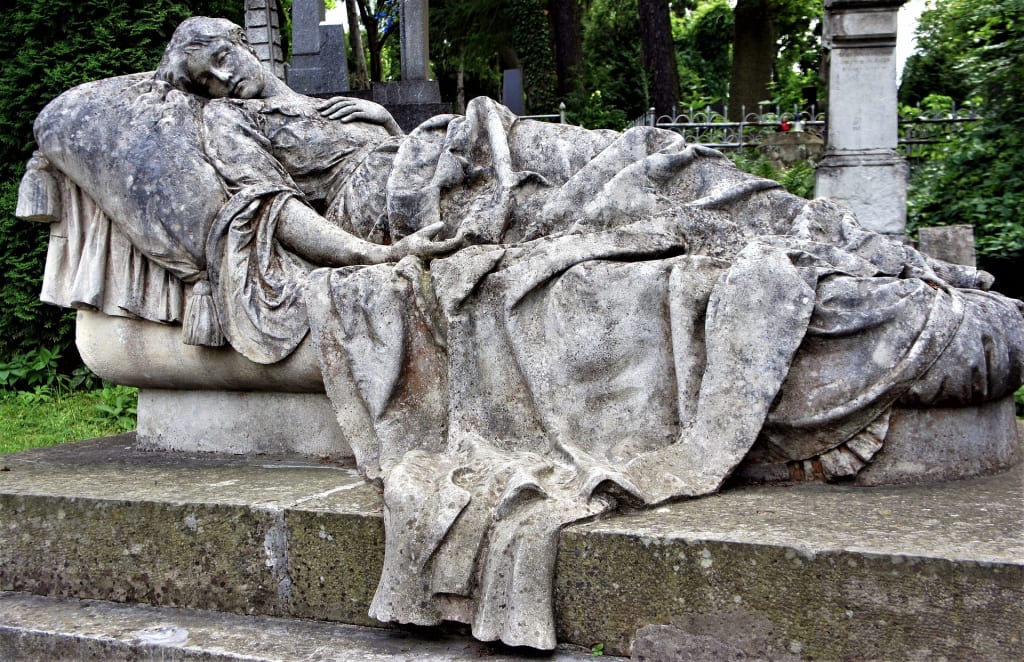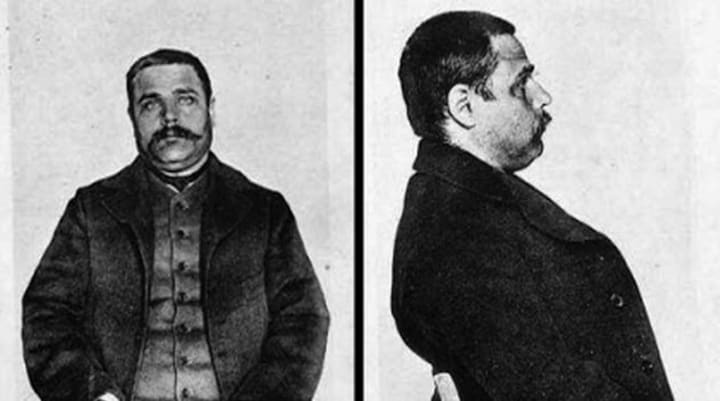
The subject of necrophilia is one that is near and dear to my sordid spirit; there is something in the obsessive love for an idealized (albeit dead) paramour that strikes us as the very height of deeply touching romantic love.
We have written not one, but TWO small books (our novel Buried, as well as The Men Who Loved the Dead, an unpublished monograph on the subject.) about romantic necrophilia; "romantic necrophilia" as distinguished from "opportunistic necrophilia," or one of the other classifications given by Dr. Anil Aggrawal in his excellent text Necrophilia: Medico-Legal and Forensic Aspects. (Which, when I borrowed it through Interlibrary Loan, no doubt left the library staff even more leery of me than they previously had been.)
Necrophilia is a practice both odious and morbidly fascinating at the same stroke; mix in the idea of someone who simply cannot let go of their loved one at their passing; who will steal the body, painstakingly preserve it as it decays, build to it a shrine, speak for it, breathe for it, imbue it with a reanimated existence (in their psychopathic brain scape, of course) and you have the makings for a never ending slew of morbid gothic potboilers.
The practice was known in the ancient world. Greek tyrant Periander, Herod the Tetrarch (who had his wife Mariamne "preserved" in honey, where after he made love to her until the remains passed the point of being detestable) and other ancient world grotesques indulged in it. For our purposes, we will recount a small list of some of our personal faves.
So, without further adieu, let us recount the Wretched Romances of the Rotten, as we present for your edification and delectation, "Five Famous Necrophiles of Morgueland." (All men recounted here, but the curious should also not discount the contributions made by such female necro- pioneers as Joan of Castile and Karen Greenlee. No chauvinists we.)
1. Henri Blot

A contemporary newspaper account of Henri Blot
We just like his name. Henri (Pronounced, we take it, "awnrey") was a little man once quoted as saying to an examining magistrate: "Each man to his taste. Mine is for corpses."
In 1886, the "pretty boy" dandy crept into a Parisian cemetery, unearthed the body of ballerina Ferdinand Mero, laid aside the bouquets of flowers, and upon a covering of paper, ravished the cold husk of flesh, thereafter falling to blissful, somnolent slumber. Upon awakening, it is said he barely had enough time to pull up his breeches and depart before risking discovery by the gendarmes. Alas, the next time he endeavored to disinter a corpse (curiously, also that of a young ballerina) he would not be so lucky.
2. Sergeant Francois Bertrand

A necrophile's necrophile, Sergeant Bertrand was, quite apparently, a misfit his entire life--in the army, he was known to not even visit prostitutes, as his erotic predilections prevented him from making love in a conventional manner. Be that as it may, the "Vampire of Montparnasse" was more than adept at stealing into cemeteries at night, exhuming the bodies of young women (his preferred victims) and ravishing them. Thereafter, he would dismember them in a mad heat of passion. Your present author well remembers coming across a book as a child, wherein was related a scenario depicting Bertrand getting into a little boat, rowing across a river to the gates of a craggy, forgotten boneyard, and stealing inside. He had apparently been drawn by some psychic force of love too great for him to withstand.
There, finding a freshly buried beauty to unearth, he quickly commenced exhumation, and lay with her, a truly gruesome tableaux for anyone that would happen upon the scene, underneath the winking stars.
But, here we have a selection or two of his own confessions:
"...After a few days of rest, the sickness came back, more violent than ever. We were staying in the Ivry Camp; at night, the guards were posted very near and their instructions were very severe, but nothing could stop me. I climbed out of the camp every night, to go to the Montparnasse Cemetery..."
Some fellows and their strange ways!
He was arrested and jailed in 1841.
3. Victor Ardisson

The French seem to have more than their fair share of famous necros. Such as "Victor of the Heavenly Eyes."
The baby-faced, beatific "Vampire of Muy," who spent his debased, debauched childhood performing grotesque acts at school, went, as naturally as a pig in manure, to the profession of sexton at a local cemetary. It was here that he robbed corpses of clothing and other valuables; even though, of course, the stuff was often rather wretched and noxious. Also, he stole a number of bodies, or pieces of them. Ardisson, who bore an almost weirdly holy look in his psychotic gaze, confessed himself at a genuine loss when the severed heads of his corpse-brides failed to answer him when he .
Here again, we have some pointed confessions:
"...It was nearly midnight, when I left the graveyard carrying the body beneath my left arm, and pressing her against my face with my right arm. On my way home, I kissed my burden and told her, "I am bringing you back home. I will not hurt you. You will be fine." Quite luckily, I met no one back home. I laid down next to the corpse telling her, "I love you sweetie." I slept well. When I woke up in the morning […]I told her, "I'm going to work. I will come back soon, if you want something to eat, just ask." She did not answer, so I guessed she was not hungry.
Victor was caught and sentenced to confinement in a mental asylum in 1901.
4. Jean Baptiste

The legend of Jean Baptiste is one of Salt Lake City Utah's most famous. In 1861, a man named Moroni Clawson, attempting the political assassination of a sitting Governor known to be unfriendly to Mormons, escaped from custody and was himself killed by lawman Henry Heath. Heath, sorrowful at having had to kill the man, later provided for the indigent Clawson a new burial suit. Days later, when the body was to be moved for reburial elsewhere, Clawson's brother was intensely disturbed to find that the body was completely naked! Suspecting grave robbery, Heath confronted gravedigger Jean Baptiste at his home.
A crate of baby shoes and other articles of clothing, most boiled in lye to kill vermin, suggested that Baptiste had a long-standing practice of robbing HUNDREDS of graves. And, furthermore, given the condition in which Clawson's body was found, it was likewise suspected that Baptiste might have been doing a little more to the corpses than merely robbing them of burial clothes and other valuable goods.
A howling mob, incensed and ready to lynch Baptiste, gathered outside the jail, and none other than Brighman Young himself was forced to come forward and reassure the believers that their relatives would rise from the graves wearing the clothes they were originally buried in come Judgement Day. Baptiste was exiled to prevent mob justice from seizing him: first to Antelope island, and later to Fremont Island, in the Great Salt Lake, where he was deposited either with or without a ball-and-chain, depending on which version you believe.
BUT, the story does not end there.
Cattle herders (what were they doing on the island? One wonders.) later visited, finding strips of leather and chopped wood, and no Jean Baptiste. They guessed, probably correctly, that he had built for himself a raft, and escaped his imprisonment. He was never seen again.
His ghost was, though. And, who knows, maybe he still walks lonely Fremont Island to this day, his soul tormented among the lonely dead that he...loved.
5. Count von Cosel

The "World Heavyweight Champion Necro" himself, Carl Otto Tanzler, a.k.a "Count von Cosel" (as he fancied himself), was an eccentric (some would even say mad) German immigrant who had spent time in an interment camp in Australia during WW1. Later moving to Havana, where a vision in the Campo de Santo cemetery, and a visit by his ancient, titled ancestor, Countess von Cosel, revealed to him the image of his "one undying love," Carl finally ended up immigrating to Key West, Florida.
The quack "Doctor" would become a radiological technician at a military hospital in Key West, would endeavor to build his own airplane, and would become infatuated with a very much younger Cuban immigrant girl named Elena Milagro de Hoyos, who had contracted tuberculosis from working in a cigar factory. No matter, Carl assured her family, his quack nostrums (including puzzling experiments with electrical apparatus) could cure her. As he was undertaking this endeavor, he lavished gifts upon his Elena, becoming more and more obsessed.
"Undying Love"

Elena de Hoyos and her remains
Predictably, von Cosel's nutty cures did NOT cure Elena, and she died in 1931. Carl then had constructed for her a special tomb, where he would sit, singing old Spanish songs to her casket, weeping and wailing; ultimately, psychologically unable to "just let go."
He finally stole the body, living with it in his home for a period of five years. As it decayed, he patiently reconstructed the putrid flesh, using strips of silk dipped in paraffin, wiring the bones back together as they deteriorated and fell to pieces; of course, he bought large quantities of bug spray, and perfume to mask the putrid odor.
He was finally discovered by Elena's sister, who, suspecting Elena was not in her tomb, confronted the amorous old lunatic. The result of all of his careful, patient care was a weirdly horrific monstrosity, a thing that looked like a giant porcelain doll. Nothing really human was left in the features, nothing "real."
The remains were put on display and thousands of people in Key West filed past to view them. (These folks were starved for entertainment, we take it.)
Carl was never prosecuted; the statute of limitations on his crime had run out years ago, and the prosecutor couldn't properly define exactly what, if any, crime he had committed since. Carl was let go, having received many kind letters of sympathy from women admirers who were touched by his "undying love."
Carl died in 1952. he was found clutching a plastic death mask of his Elena.
Undying love, indeed.
About the Creator
Tom Baker
Author of Haunted Indianapolis, Indiana Ghost Folklore, Midwest Maniacs, Midwest UFOs and Beyond, Scary Urban Legends, 50 Famous Fables and Folk Tales, and Notorious Crimes of the Upper Midwest.: http://tombakerbooks.weebly.com






Comments
There are no comments for this story
Be the first to respond and start the conversation.